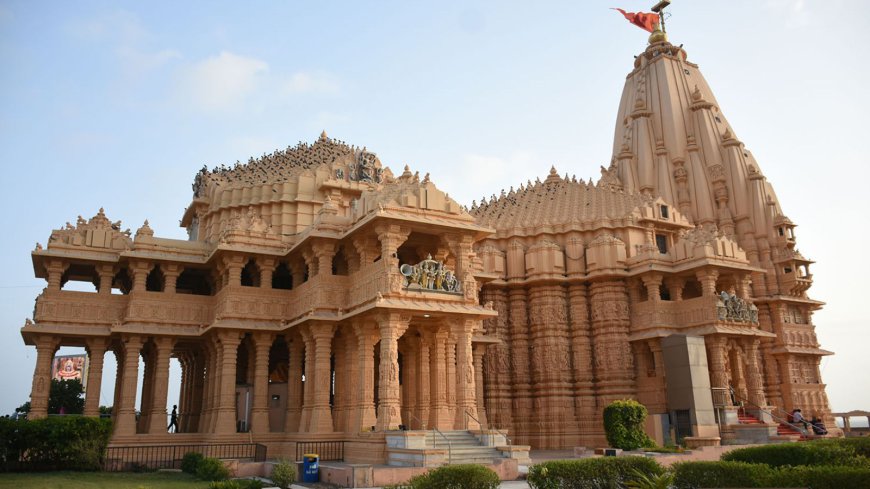Somnath Temple: A Sacred Jewel of Gujarat
Discover the rich history, spiritual significance, and breathtaking architecture of the Somnath Temple in Gujarat, India. Explore travel tips, legends, and must-visit nearby attractions in this comprehensive guide.

Somnath Temple, located in the Prabhas Patan region near Veraval in Gujarat, is more than just an architectural marvel; it is a revered spiritual destination and an integral part of India’s rich heritage. Known as the first of the 12 Jyotirlingas, the temple is dedicated to Lord Shiva and draws millions of devotees and tourists every year. Its rich history, cultural significance, and majestic beauty make it one of the most important Hindu shrines.
History of Somnath Temple
The Somnath Temple has an extraordinary history marked by faith, destruction, and resilience. Believed to have been originally constructed by the Moon God, Soma, as per Hindu mythology, the temple has been destroyed and rebuilt several times due to repeated invasions by foreign rulers. Its first known historical reference dates back to the reign of the Chalukyas in the 8th century AD. Successive reconstructions by Hindu kings, particularly by King Bhimdev I of the Solanki dynasty, and later by Sardar Vallabhbhai Patel in modern times, underline its resilience and significance in Indian culture.
Architecture of Somnath Temple
The present structure of Somnath Temple follows the Chalukya style of architecture and is renowned for its intricate carvings, majestic shikhar (spire), and detailed craftsmanship. Standing tall at 155 feet, the temple’s shikhar is capped by a golden kalash (finial). The temple also houses a central jyotirlinga of Shiva, revered for its spiritual energy and importance. Visitors are captivated by the serene aura, expansive courtyard, and sea-facing view, making it a visual delight.
Location and Accessibility
Situated along the western coast of Gujarat, the Somnath Temple is easily accessible by various modes of transport:
- By Air: The nearest airport is Diu Airport, around 63 kilometers away. Rajkot Airport, at 190 kilometers, serves as a larger hub for travelers.
- By Rail: Veraval Railway Station, merely 7 kilometers from the temple, offers regular train services.
- By Road: Somnath is well-connected by highways and is reachable by buses and taxis from major cities like Ahmedabad, Rajkot, and Vadodara.
Significance of Somnath Temple in Hinduism
The Somnath Temple holds a special place as one of the 12 Jyotirlingas, each representing a unique manifestation of Lord Shiva. For devotees, visiting this temple signifies achieving salvation and cleansing of sins. Rituals performed here include daily aarti, Rudrabhishek, and special prayers during Mahashivratri, which attract throngs of worshippers.
Reconstruction Efforts Over the Centuries
The temple's resilience is a testament to the faith and dedication of countless devotees. During the medieval period, it faced multiple invasions by rulers like Mahmud of Ghazni, who sought to plunder its wealth. However, each time it was destroyed, the temple rose again, stronger than before. Post-independence, under the guidance of Sardar Vallabhbhai Patel, the current structure was reconstructed, symbolizing India’s resurgence and reclaiming of its cultural heritage.
Legends Associated with Somnath Temple
One of the most captivating legends associated with the temple is the story of Soma, the Moon God, who worshipped Lord Shiva to regain his lost luster and grace. This act of devotion led to the temple being known as "Somnath," meaning the "Protector of the Moon." Many such myths and tales enrich the temple’s spiritual significance, weaving history with folklore.
Best Time to Visit Somnath Temple
The ideal time to visit Somnath Temple is between October and February when the weather is pleasant. Devotees can also time their visit to coincide with major festivals like Mahashivratri, Kartik Purnima, and Shravan month celebrations, which offer a glimpse into the temple’s grand traditions.
Nearby Attractions Around Somnath
- Somnath Beach: Just a short distance from the temple, the beach offers serene views of the Arabian Sea.
- Bhalka Tirtha: Believed to be the site where Lord Krishna left his earthly body.
- Prabhas Patan Museum: A treasure trove of ancient artifacts and remnants related to the temple’s rich history.
- Gir National Park: A wildlife sanctuary known for its Asiatic lions, located around 45 kilometers away.
Somnath Temple’s Role in Modern India
Today, the Somnath Temple stands as a symbol of national pride and spiritual resilience. It has become a major tourist attraction, drawing people from all walks of life who seek solace, historical insights, and cultural experiences.
Visitor Information
- Timings: The temple remains open daily from 6 AM to 9 PM, with a special light and sound show in the evening.
- Dress Code: Modest attire is recommended to maintain the sanctity of the temple.
- Etiquette: Photography inside the temple premises is prohibited, and visitors are advised to maintain silence and respect the religious customs.
Accommodation Near Somnath Temple
There are numerous options for accommodation near the temple, ranging from luxurious hotels to budget-friendly guesthouses and dharamshalas catering to pilgrims.
Cultural Festivals and Events
Somnath Temple comes alive during grand celebrations of Mahashivratri and Kartik Purnima. Devotees from far and wide gather to participate in rituals, prayers, and spiritual discourses that infuse the air with vibrancy and devotion.
Devotees’ Experiences and Stories
Many devotees recount transformative experiences and moments of peace upon visiting Somnath. For some, it is a journey of faith; for others, it is a cultural odyssey steeped in history and divinity.
Conclusion
The Somnath Temple is more than just a religious structure; it embodies India’s spirit of perseverance and devotion. A journey to this sacred place leaves one humbled by its architectural splendor and inspired by its rich legacy of faith.
FAQs
-
What is the significance of Somnath Temple as a Jyotirlinga?
The Somnath Temple is the first among the 12 Jyotirlingas, symbolizing the infinite power and presence of Lord Shiva. -
Who rebuilt the Somnath Temple after multiple invasions?
It was reconstructed several times, with the current structure being built under the guidance of Sardar Vallabhbhai Patel after India’s independence.
